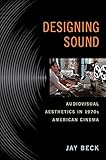Designing Sound : Audiovisual Aesthetics in 1970s American Cinema / Jay Beck.
Material type: TextSeries: Techniques of the Moving ImagePublisher: New Brunswick, NJ : Rutgers University Press, [2016]Copyright date: ©2016Description: 1 online resource (274 p.) : 25 photographsContent type:
TextSeries: Techniques of the Moving ImagePublisher: New Brunswick, NJ : Rutgers University Press, [2016]Copyright date: ©2016Description: 1 online resource (274 p.) : 25 photographsContent type: - 9780813564142
- 9780813564159
- 791.4302/4 23
- PN1995.7 .B43 2016
- PN1995.7
- online - DeGruyter
- Issued also in print.
| Item type | Current library | Call number | URL | Status | Notes | Barcode | |
|---|---|---|---|---|---|---|---|
 eBook
eBook
|
Biblioteca "Angelicum" Pont. Univ. S.Tommaso d'Aquino Nuvola online | online - DeGruyter (Browse shelf(Opens below)) | Online access | Not for loan (Accesso limitato) | Accesso per gli utenti autorizzati / Access for authorized users | (dgr)9780813564159 |
Browsing Biblioteca "Angelicum" Pont. Univ. S.Tommaso d'Aquino shelves, Shelving location: Nuvola online Close shelf browser (Hides shelf browser)

|

|

|

|

|

|

|
||
| online - DeGruyter Torture Porn in the Wake of 9/11 : Horror, Exploitation, and the Cinema of Sensation / | online - DeGruyter Like Family : Narratives of Fictive Kinship / | online - DeGruyter Shot on Location : Postwar American Cinema and the Exploration of Real Place / | online - DeGruyter Designing Sound : Audiovisual Aesthetics in 1970s American Cinema / | online - DeGruyter Rutgers since 1945 : A History of the State University of New Jersey / | online - DeGruyter Monstrous Progeny : A History of the Frankenstein Narratives / | online - DeGruyter Sound : Dialogue, Music, and Effects / |
Frontmatter -- Contents -- Acknowledgments -- 1. Introduction: The State of the Art -- PART ONE. General Trends (1965-1971) -- 2. The British Invasion -- 3. TV and Documentary's Influence on Sound Aesthetics -- 4. New Voices and Personal Sound Aesthetics, 1970-1971 -- PART TWO. Director Case Studies (1968-1976) -- 5. Francis Ford Coppola's American Zoetrope and Collective Filmmaking -- 6. Robert Altman's Collaborative Sound Work -- 7. Martin Scorsese's Dialectical Sound -- PART THREE. The Dolby Stereo Era (1975-1980) -- 8. The Sound of Music -- 9. The Sound of Spectacle: Dolby Stereo and the New Classicism -- 10. The Sound of Storytelling: Dolby Stereo and the Art of Sound Design -- Notes -- Selected Bibliography -- Index
restricted access online access with authorization star
http://purl.org/coar/access_right/c_16ec
The late 1960s and 1970s are widely recognized as a golden age for American film, as directors like Francis Ford Coppola, George Lucas, and Martin Scorsese expanded the Hollywood model with aesthetically innovative works. As this groundbreaking new study reveals, those filmmakers were blessed with more than just visionary eyes; Designing Sound focuses on how those filmmakers also had keen ears that enabled them to perceive new possibilities for cinematic sound design. Offering detailed case studies of key films and filmmakers, Jay Beck explores how sound design was central to the era's experimentation with new modes of cinematic storytelling. He demonstrates how sound was key to many directors' signature aesthetics, from the overlapping dialogue that contributes to Robert Altman's naturalism to the wordless interludes at the heart of Terrence Malick's lyricism. Yet the book also examines sound design as a collaborative process, one where certain key directors ceded authority to sound technicians who offered significant creative input. Designing Sound provides readers with a fresh take on a much-studied era in American film, giving a new appreciation of how artistry emerged from a period of rapid industrial and technological change. Filled with rich behind-the-scenes details, the book vividly conveys how sound practices developed by 1970s filmmakers changed the course of American cinema.
Issued also in print.
Mode of access: Internet via World Wide Web.
In English.
Description based on online resource; title from PDF title page (publisher's Web site, viewed 30. Aug 2021)


